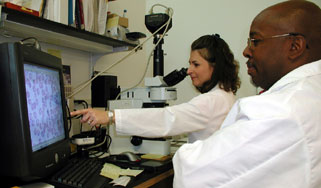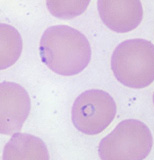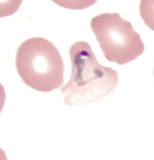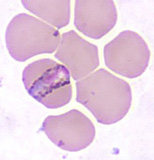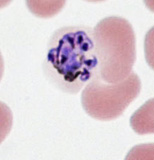 |
Malaria Telediagnosis
CDC uses the Internet to assist remote laboratories
in the microscopic diagnosis of malaria…
|
|
|
Stephanie Johnston and Henry Bishop of CDC's Division of Parasitic Diseases discuss telediagnosis images received through the Internet. |
 |
 |
Blaine Mathison at his telediagnosis station at the Arizona State Laboratory. The view through the microscope is shown on the computer monitor. Images can be captured by the digital camera mounted on the microscope. The images are stored in the computer and sent by email to CDC. |
The
best way to find out whether a patient who is suspected of having malaria
actually has the disease is to look for malaria parasites in the patient’s
blood. To do this, laboratory workers collect a blood specimen from
the patient, spread some of the blood on a glass slide (to make a thick
smear and a thin smear), stain the slide, and examine it under a microscope
for the presence of malaria parasites. This procedure can be life-saving
because it helps in the diagnosis of a potentially fatal disease. However microscopic
examination for malaria requires skills and experience that are
not always available in all laboratories. For example, in the United
States malaria is rare and often laboratory workers are not sufficiently
familiar with its microscopic diagnosis.
CDC offers telediagnosis to better assist laboratory workers in diagnosis
of malaria and other parasitic diseases. When U.S. and international
laboratories are not sure about what they see when searching for malaria
parasites on a slide, they can e-mail CDC images
of the suspected parasites. In a period ranging from a
few minutes to a few hours, experts at CDC’s
Division of Parasitic Diseases (DPD) review the images and discuss the
findings with the submitting laboratory by email or by telephone. Such
contact not only allows almost “real time” diagnosis but
also offers an opportunity for training in microscopic diagnosis.
CDC, through the National Food Safety Initiative, has provided 47 public
health laboratories in the United States, and a laboratory in Guatemala
(CDC-Medical Entomology Research and Training Unit) with funding to
acquire the equipment needed for telediagnosis. This includes a digital
camera that can be attached to a microscope and a computer with Internet
access. More than 250 telediagnosis requests have been received in the
last 3 years, with an increasing trend during that period . Public health
laboratories and clinical laboratories are the primary users (213 submissions),
although submissions from international laboratories (39) are on the
rise.
Telediagnosis is a component of the DPDx Project, a program to strengthen
the laboratory diagnosis of parasitic diseases. Supported through National
Food Safety Initiative funding, DPDx offers a Web
site on parasitology diagnosis, a monthly case-study listserv, CD
products, and continuing education training for laboratory workers.
Laboratories interested in participating in DPDx activities (including
telediagnosis) should contact dpdx@cdc.gov.
 past spotlights past spotlights
Page last modified : August
27,
2004
Content source: Division of Parasitic Diseases
National Center for Zoonotic, Vector-Borne, and Enteric Diseases (ZVED)
|
 |
|

